This post may contain affiliate links. Please read our disclosure policy.
These easy gluten free blueberry muffins bake up with high domes, golden crisp edges, and the perfect tender crumb—just like the kind you'd find at a bakery.
Bursting with juicy blueberries and topped with a sprinkle of coarse sugar for that irresistible crunch, they’re moist, flavorful, and made from simple pantry staples. Whether you use fresh or frozen berries, they hold their shape beautifully and never sink.
This isn’t just a basic gluten free muffin recipe with blueberries tossed in—it's carefully tested to give you muffins that rise tall, stay tender, and taste amazing every time.

Why you'll love these muffins
Bakery-style muffin tops: These muffins bake up with a golden, craggy dome—just like you'd expect from a professional bakery.
Perfect blueberry distribution: The thick batter keeps the berries from sinking, whether you use fresh or frozen.
Moist and tender crumb: Thanks to buttermilk and a touch of lemon juice, the texture is soft and fluffy, never dry or dense.
Crisp edges and sweet crunch: Melted butter and a sprinkle of coarse sugar on top create an irresistible texture contrast.
Easy, reliable recipe: No mixer needed and just one bowl for wet and one for dry—these come together fast with everyday ingredients.
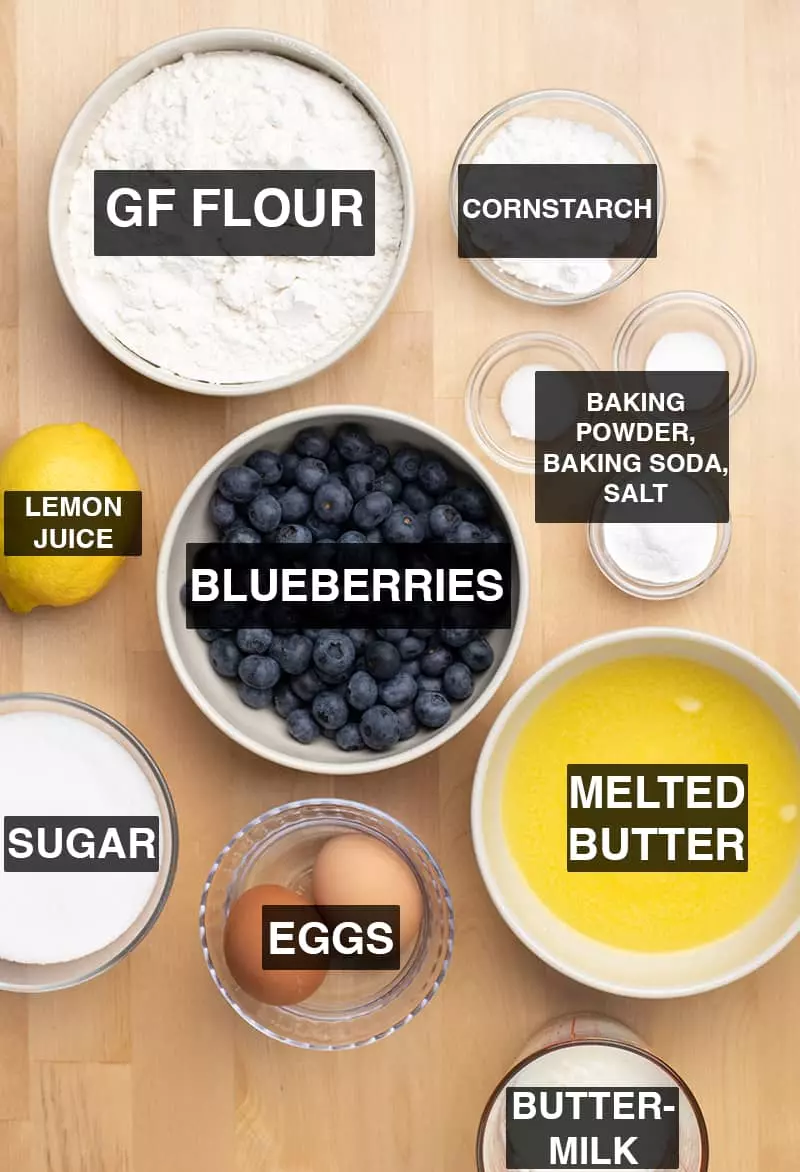
what's in it
Key ingredients for bakery-style gf blueberry muffins
- Buttermilk – Adds flavor and creates a soft, tender crumb. No buttermilk? Use half plain yogurt, half milk by volume as a quick substitute.
- Melted butter – Infuses the muffins with rich flavor and moisture.
- Fresh lemon juice – Brightens and enhances the blueberry flavor.
- Eggs – Provide structure and lift.
- Gluten free flour blend + cornstarch – A blend with superfine rice flour and added cornstarch helps mimic bakery-style texture. (See Notes in the recipe card for flour blend tips.)
- Baking powder + baking soda – Ensure a high rise and golden edges.
- Granulated sugar – Adds sweetness and tenderness to the crumb.
- Blueberries – Use fresh or frozen (unthawed) for juicy pockets of flavor in every bite.

substitutions
Ingredient substitutions
Dairy free
- Use half plain dairy-free yogurt and half unsweetened nondairy milk (like almond or soy) in place of buttermilk.
- Swap the butter for a block-style vegan butter like Miyoko’s or Melt. Avoid tub-style spreads—they’re too soft and oily.
Egg free
- Replace each egg with a chia egg, Bob’s Red Mill Egg Replacer, or JustEgg. Expect slightly less lift, but still a good crumb.
Corn free
- Use arrowroot starch or potato starch in place of cornstarch—either one works well for tender muffins.
Blueberry alternatives
- You can sub in raspberries (fresh or frozen), but if you’re craving strawberries, try my gluten free strawberry muffins instead—they’re formulated specifically for that fruit.
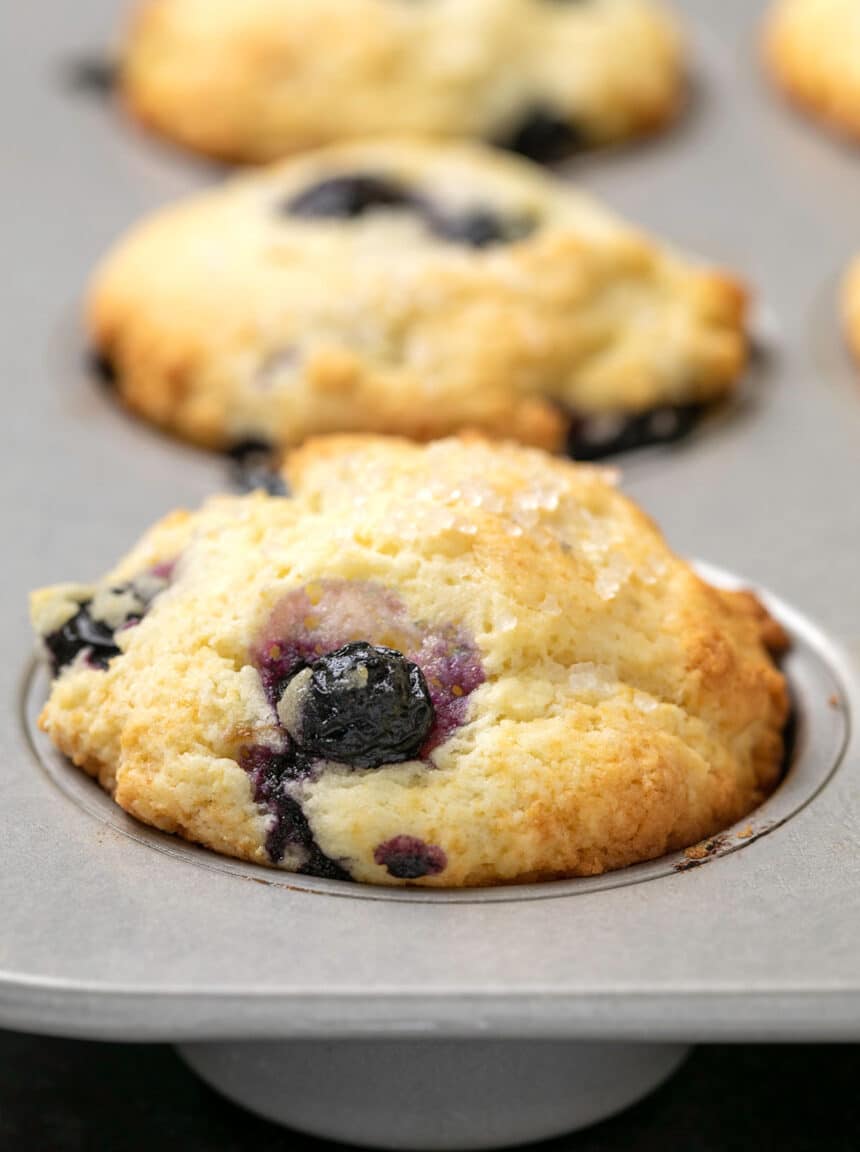
Pro tips for perfect muffins
Start hot for a high dome
Begin baking at 400°F for the first 10 minutes, then lower to 350°F to finish. The high heat activates the baking powder quickly, giving you that classic domed top.
Don’t thaw frozen blueberries
Use them straight from the freezer to prevent bleeding or wilting. Thawed berries break down and turn your batter purple.
Coat berries in flour
Tossing fresh or frozen berries in a tablespoon of the dry ingredients helps suspend them in the batter so they don’t sink.
Smooth tops for an even rise
After portioning the batter into the muffin wells, smooth the tops gently with wet fingers. This helps encourage a more even rise and prevents lopsided muffins.

How to make these muffins
Step 1: Prep the oven and pan
Preheat your oven to 400°F. Grease or line a 12-cup muffin tin and set aside.
Step 2: Mix the wet ingredients
In a medium bowl, whisk together the melted and cooled butter, buttermilk, lemon juice, and eggs until smooth.
Step 3: Whisk the dry ingredients
In a large mixing bowl, combine the gluten free flour blend with xanthan gum, cornstarch, baking powder, baking soda, salt, and sugar.
Step 4: Toss the blueberries
Use 1 tablespoon of the dry mixture to coat your fresh or frozen blueberries so they don't sink to the bottom.
Step 5: Combine wet and dry
Pour the wet mixture into the dry ingredients. Stir until just combined—the batter will be thick.

Step 6: Fold in the berries
Gently fold in the coated blueberries just until evenly distributed.
Step 7: Fill the muffin tin
Divide the batter evenly among the muffin cups, filling them nearly full. Smooth the tops with wet fingers for an even rise.
Step 8: Add the topping
Brush with melted butter and sprinkle with coarse sugar, if using.
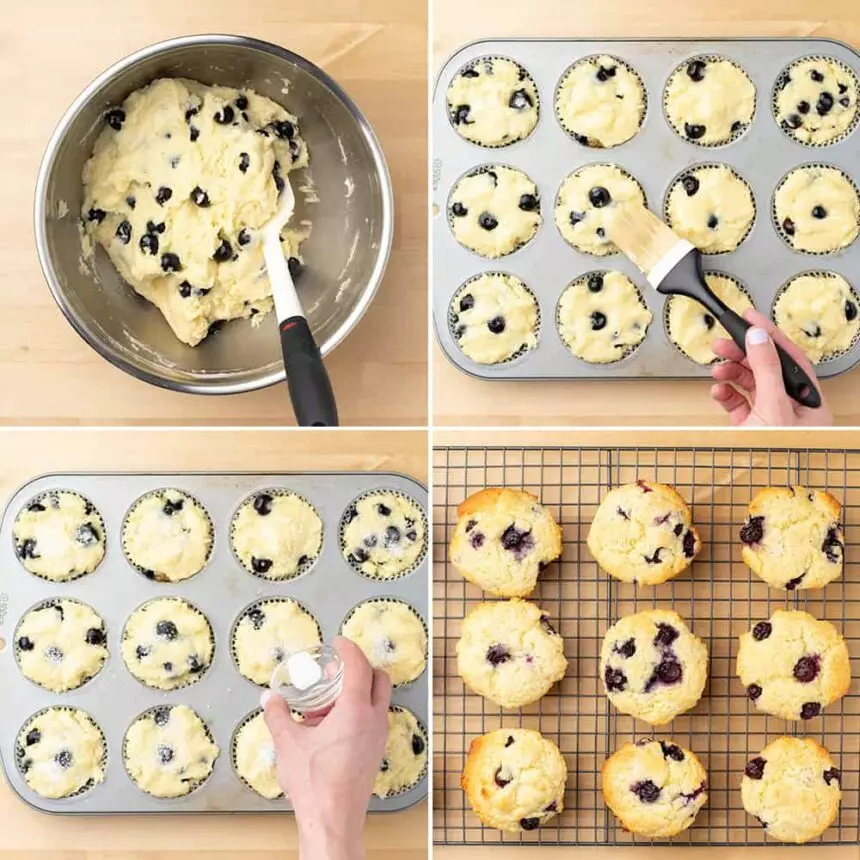
Step 9: Bake
Bake at 400°F for 10 minutes, then reduce the temperature to 350°F and bake for another 10–12 minutes, or until a toothpick comes out with a few moist crumbs.
Step 10: Cool
Let the muffins cool in the tin for 10 minutes, then transfer to a wire rack to finish cooling.
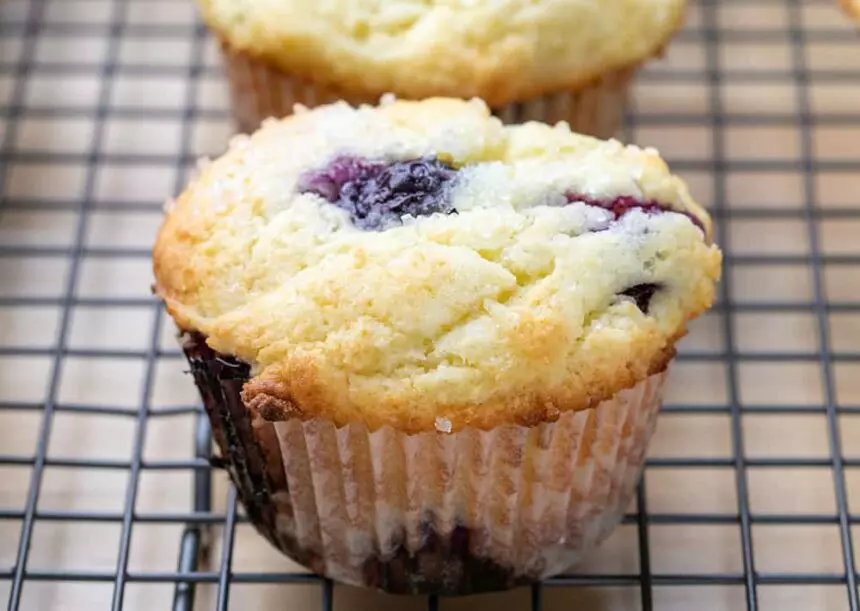
Gluten Free Blueberry Muffins Recipe
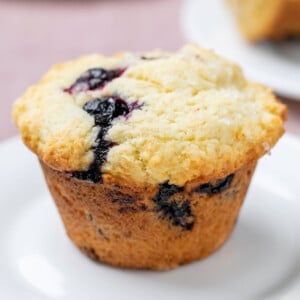
Ingredients
For the muffin batter
- ¾ cup (6 fluid ounces) buttermilk, at room temperature
- 10 tablespoons (140 g) unsalted butter, melted and cooled
- 2 tablespoons (1 fluid ounce) freshly-squeezed lemon juice
- 2 (100 g (weighed out of shell)) eggs, at room temperature
- 2 ½ cups (350 g) all purpose gluten free flour blend, (See Recipe Notes)
- 1 ¼ teaspoons xanthan gum, omit if your blend already contains it
- ¼ cup (36 g) cornstarch, See Recipe Notes
- 4 teaspoons baking powder
- ½ teaspoon baking soda
- ½ teaspoon kosher salt
- 1 cup (200 g) granulated sugar
- 1 ¼ cups (250 g) fresh or frozen blueberries, (See Recipe Notes)
For the optional topping
- 1 tablespoon (14 g) unsalted butter, melted
- Coarse sugar, for sprinkling
Instructions
Make the muffin batter
- Preheat your oven to 400°F. Grease or line a 12-cup muffin tin and set aside.
- In a medium bowl, whisk together the buttermilk, melted butter, lemon juice, and eggs until well combined.
- In a large bowl, whisk together the flour, xanthan gum (if using), cornstarch, baking powder, baking soda, salt, and sugar.
- Set aside 1 tablespoon of the dry mixture. Toss the blueberries in that flour to coat.
- Create a well in the center of the dry ingredients. Add the wet mixture and mix until just combined. The batter will be thick.
- Gently fold in the floured blueberries until evenly distributed.
- Divide the batter evenly among the muffin cups. Smooth the tops with wet fingers.
- Brush tops with melted butter and sprinkle with coarse sugar, if using.
Bake the muffins
- Bake at 400°F for 10 minutes. Then reduce heat to 350°F and bake for another 10–12 minutes, until a toothpick inserted in the center comes out with a few moist crumbs (avoid testing in a blueberry).
- Finish baking the muffins at 350°F until a toothpick inserted in the center (and not in a blueberry) comes out with no more than a few moist crumbs attached (10 to 12 minutes more).
- Let muffins cool in the tin for 10 minutes before transferring to a wire rack.
Video
Notes
These muffins work best with a well-balanced gluten free flour blend like Better Batter or Nicole’s Best. If using Bob’s Red Mill 1-to-1, add ½ teaspoon extra xanthan gum to avoid a crumbly texture. Avoid Cup4Cup—its updated formula doesn’t perform well here. For DIY blend instructions, visit my all purpose GF flour blends guide. Using frozen blueberries
Don’t thaw them! Use straight from the freezer and toss in dry ingredients before folding into the batter. Dairy free version
Use half plain dairy-free yogurt and half unsweetened non-dairy milk instead of buttermilk. Swap butter for block-style vegan butter (like Miyoko’s, Melt, or Earth Balance sticks).
Nutrition
Nutrition information is automatically calculated, so should only be used as an approximation.
make ahead/leftovers
How to store and freeze gluten free blueberry muffins
Room temperature:
Store fully cooled muffins in an airtight container at room temperature for up to 2 days. Wrap individually in plastic wrap for best texture.
Freezer-friendly:
These muffins freeze beautifully. Place completely cooled muffins on a baking sheet to flash-freeze, then transfer to a freezer-safe container or zip-top bag.
To reheat:
- Toaster oven: For a crisp edge and warm center, sprinkle lightly with water and bake at 250°F for 5 minutes or until warmed through.
- Microwave: Heat a frozen muffin for 30 to 45 seconds at 50% power.
FAQs
Not quite. Buttermilk is thicker and more acidic than milk, which helps create a tender crumb. For the best results, use half plain yogurt or sour cream and half milk as a substitute.
It adds brightness and balances the sweetness. It also enhances the blueberry flavor. You can substitute ½ teaspoon vanilla extract if you don’t have lemon juice.
No—this batter is formulated for muffins. For a gluten free blueberry loaf, try my gluten free blueberry bread.
Yes! Bake at 400°F for 5 minutes, then reduce to 350°F and bake for about 9 more minutes, or until a toothpick comes out clean.
You can refrigerate it in the muffin tin, covered. Let it sit at room temperature for 20–30 minutes before baking for the best rise.
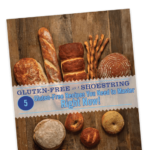
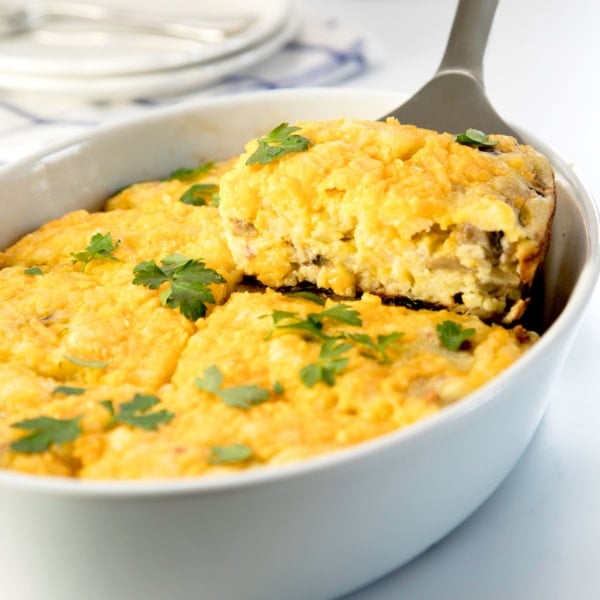
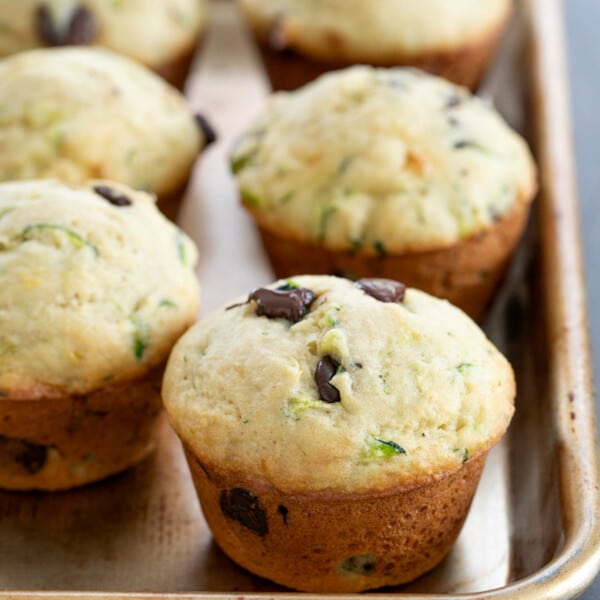

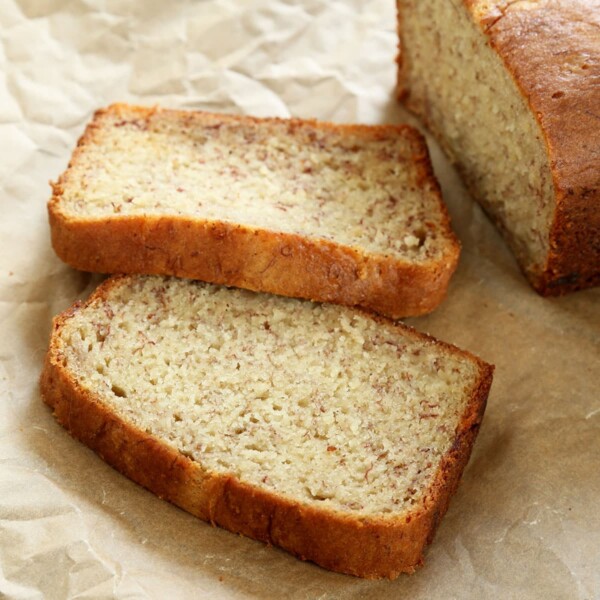









Hi Nicole, I made your blueberry muffins with Mock Better Batter and followed both recipes very carefully. The trouble i encountered was I could not fit all the batter in my tin, so I wound up with 16 muffins instead of 12, meaning mine were obviously smaller and baked differently than yours. I have been looking at muffin pans and wonder if you could share what yours is to help me decide on which one to purchase. ALSO, I liked your muffin recipe, but would like to add sugar to it. Would that in any way change the recipe adversely?
Hi, Judy, there is considerable variation in the size of the wells in muffin tins, so it’s not a huge surprise that you couldn’t fit all the batter in the wells of yours. All you have to keep in mind is that in smaller wells, the muffins will bake faster. I actually really like the Wilton brand Recipe Right muffin tins. They’re light, bake evenly, and they’re light in color, which is ideal. I’m afraid I don’t know how this recipe will work with more sugar added, since baking is chemistry and every change has an effect that can’t necessarily be predicted. You’d have to experiment!
Hi Nicole,
I have made many of your recipes and they are all so delicious! It’s blueberry season and your GF blueberry muffin recipe is my favorite. I love the taste of lemon with the blueberries. I didn’t have buttermilk and made it using half&half, lemon juice and zest.
I plan to make your blueberry cobbler next. It looks amazing. It’s all about blueberries right now! lol
Thanks,
T
Hi, T, so glad you love this recipe. It doesn’t get much exposure on Google for some reason, but it’s so great and I’m so glad you know that. I hope you love the blueberry cobbler!
I adore all of Nicole’s recipes- they are always very sucessful and I share even with normal gluten freinds! Thank you from Brisbane Australia
Excellent sounding recipe. I’ll try it soon.
Nicole, I love your recipes! I have been using them for years. I am making these with your “Nicole’s Best Flour” so I read the notes at the end of the recipe carefully. I notice that in the recipe for substitutes you say that the buttermilk can be replaced with 3 ounces of milk and 3 ounces of plain yogurt. However, in the notes that show up with the printed recipe, it instructs to use 1/2 milk and 1/2 milk to substitute for the buttermilk. I read it three times to make sure I read it as it was written. I was able to write by hand the corrected substitution note on my printed recipe but I wanted to let you know as it might be confusing to a newbie making this recipe. Again, you have the very best and reliable GF recipes of all the web sites!!
Hi, Judy, 1/2 milk and 1/2 yogurt, in this particular recipe, is 3 fluid ounces milk, 3 fluid ounces yogurt. The total amount of buttermilk is 6 fluid ounces, half of which is 3. I think you may have just been overthinking it in an effort to get it just right, which I very much appreciate. I hope that’s helpful, and thank you for the kind words!
Nicole, your flour has the Milk Powder in it right? The Cup4Cup doesn’t have that anymore in it and Better Batter flour doesn’t have this anymore either right?
Just your flour has it?
I can’t add the Milk Powder to either one of these bags of Full Flour?
Thanks Jennifer
Hi, Jennifer, correct, Nicole’s Best has milk powder as an ingredient in the overall blend. If you’re trying to mimic the results you get with my flour by adding milk powder to one of those other blends, that will not work. Our blend can’t be hacked like that. The only way to get the results that you enjoy with Nicole’s Best is to buy it!
Hi Nicole, should we always be sifting GF flour in all your recipes? Even if you don’t mentioned it in the recipe?
And should the cornstarch always be sifted too, even if’s not mentioned in the recipe?
Thanks Jennifer
Hi, Jennifer, nope, you only need to sift the flour blend, or any other ingredient, if the recipe specifically directs you to do it. The vanilla cake, angel food cake, and a few other recipes. I’m very specific, and would never expect you to do something that I hadn’t explicitly stated.
I have recently bought Nicole’s Best GF Flour and tried it with a few things with great success! For this recipe do I make any changes if that’s the flour I’m going to use? Thanks
Hi, Elaine, I’m so glad you’re enjoying Nicole’s Best! There are no changes, other than being sure to add xanthan gum, since Nicole’s Best doesn’t contain any.
Fantastic, super delicious and crunchy. Made all the way in South Africa ;)
Wonderful recipe! These muffins turned out beautiful and delicious. I used your flour blend recipe with the pectin added, and it worked very well for this recipe. It works quite well for most recipes. I find it very versatile. I love the cornstarch in this recipe. It gives the muffins such a delightful texture! Thank you for another great recipe.
You’re very welcome, Marianna. Yes, the mock Better Batter will work in any of my recipes that call for an all purpose gluten free flour blend. The added cornstarch in these muffins definitely makes them softer. Thanks for sharing your experience!